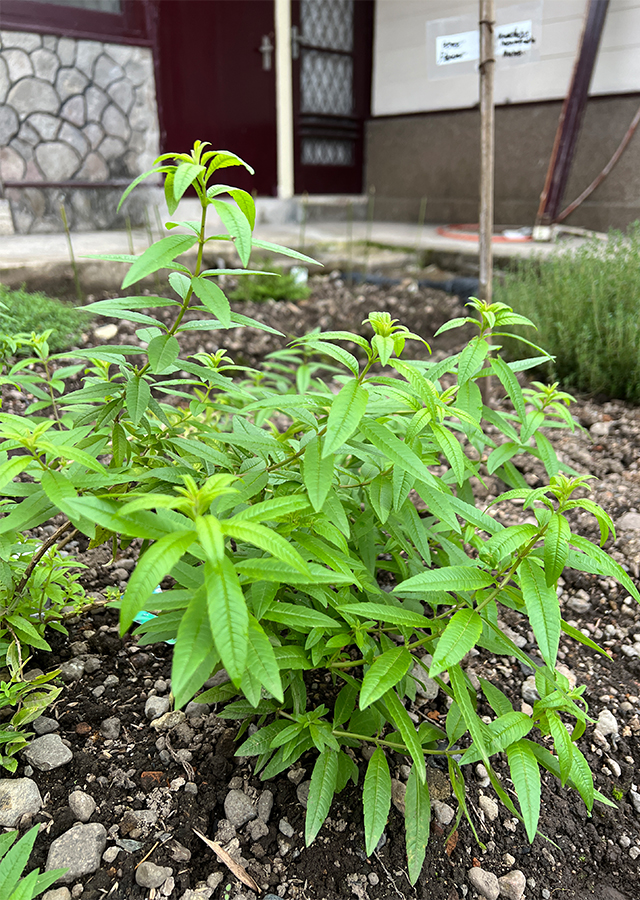Lemon Verbena
Aloysia citrodora Paláu
Verbenaceae
Location in our garden
Principal



Synonym
Aloysia triphylla Britton
Lippia citrodora (Palau) Kunth
Verbena citrodora (Palau) Cav.
Habitus
Shrubs. Shrub 1-3 m high, aromatic
Part Used
Leaves
Growing Requirements
Full Sunshine
Need Shade
Habitat
Roadside
Shrublands
Terrestrial
Overview
Aloysia citrodora is a shrub native to Argentina, Bolivia and Paraguay that has been widely introduced in tropical and warm climates as an aromatic, ornamental and medicinal plant. Cultivated and naturalized throughout North and South America, the Mediterranean, Africa and India. Often grown in gardens and as a potted plant. Currently, A. citrodora is listed as invasive in Cuba and South Africa, and can be found naturalized in a variety of habitats and regions around the world. It is included in the Global Compendium of Weeds. The leaves are used to add a lemon flavor to foods, beverages and liquors, are consumed as a vegetable in salads and soups, and are used to make herbal teas. The essential oil extracted from the leaves is used in perfumery and aromatherapy. Aloysia citrodora is also a popular medicinal herb used to treat digestive disorders.
Vernacular Names
Cedrón (Spanish), Verveine citronelle (French), Salva-limão (Portuguese), Yerba luisa (Cuban).
Agroecology
Aloysia citrodora can be found growing in dry scrub, open fields and along roadsides. It is adapted to grow in semi-arid habitats but can also grow in humid tropical habitats. Aloysia citrodora grows in tropical and warm climate zones at altitudes from sea level to about 2000 m. It grows well in areas with an average annual temperature ranging from 18°C to 28°C (tolerates 14°C - 33°C) and an average annual rainfall ranging from 600 mm to 1,000 mm (tolerates 500-1800 mm). Mature plants can die at -12°C and seedlings and young plants can be severely damaged at 0°C. It prefers fertile, well-drained soil with a pH of 5.5 - 7.5. Excess water triggers root rot.
Morphology
- Stems - glabrous at maturity, subpendulous.
- Leaves - ternate, briefly petiolate, petioles 1-5 mm; blades elliptic, 2-8 × 1-2.5 cm, apex acute, base acute, margins entire or slightly serrate, blade adaxially scabrous, abaxially glabrate with subsessile glandular trichomes, midvein and pinnate venation conspicuous.
- Flowers - Inflorescences terminal and axillary (heterothetic pleiobotrya), lax,1-5 cm, the terminal ones grouped as paniculiform inflorescences; flowers white, small; floral bracts reduced, ovate, 1-1.5 mm, scabrous. Flower with the with calyx 2.5-3 mm, puberulous, with 4 brief teeth, unequal, triangular; corolla tube 5-6 mm, externally puberulous. Cluse 2 × 1 mm, glabrous or pubescent at apex.
Cultivation
- Propagated by seeds, cuttings or clump division.
- The seeds are dispersed by the wind and the fruit are dry schizocarps that can spread by attaching to animals and humans.
Chemical Constituents
Terpenoids and phenolic compounds, verbascoside, geranial, neral, luteolin, and limonene.
Traditional Medicinal Uses
- Reducing inflammation and oxidative stress.
- Protecting your cells from damage.
- Treating digestive disorders (digestive, antispasmodic, carminative, antidiarrheal), insomnia, rheumatism.
- Reducing fever, mild sedative, cardiotonic.
- Prevent cancer.
- Improve sleep quality.
- Acts as an analgesic and antiseptic
Part Used
Reference Sources
- Royal Botanic Gardens. Plants of the World Online: Aloysia citrodora Paláu. https://powo.science.kew.org/taxon/urn:lsid:ipni.org:names:1015994-1. 16-09-22.
- CAB International. 2022. Invasive Species Compendium: Aloysia citrodora (lemon verbena). https://www.cabi.org/isc/datasheet/112152#tosummaryOfInvasiveness. 16-09-22.
- Healthline. 5 Potential Health Benefits of Lemon Verbena. Aloysia citrodora. https://www.healthline.com/nutrition/lemon-verbena-uses. 16-09-22.
